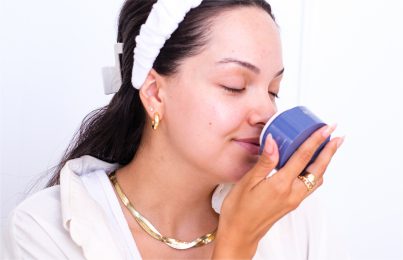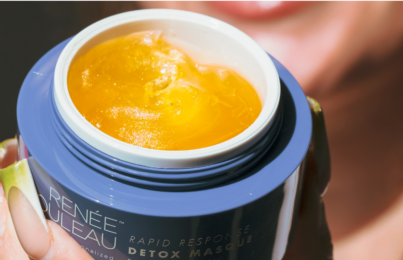Updated 12/14/21. If you have sensitive skin and/or you’re prone to clogged pores and breakouts, incorporating new skincare products into your routine can be a little intimidating. It’s hard to tell how your skin will respond even if you’ve chosen products that are specifically formulated for your skin type. The last thing you want is to accidentally initiate a negative reaction. Don’t despair—in this post, I’ll share everything you need to know in order to avoid a negative skin reaction from ever occurring.
- 1. Don’t Self-Diagnose Your Skin
- Common Mistakes People Make When Self-Diagnosing Their Skin
- Mistake #1: Focusing on One Concern Rather than Looking at the Big Picture
- Mistake #2: Thinking That Dry and Dehydrated Skin Are the Same Thing
- Mistake #3: Focusing on What Your Skin Was Like in the Past
- Mistake #4: Treating All Blemishes the Same Way
- Mistake #5: Misunderstanding the True Meaning of Sensitive Skin
- Common Mistakes People Make When Self-Diagnosing Their Skin
- 2. Perform a Patch Test Before Using a New Skincare Product
- 3. Introduce New Skincare Products Slowly
1. Don’t Self-Diagnose Your Skin
It’s important to use the resources available to you to help you understand your skin. I suggest taking the Skin Type Quiz or consulting a trusted skincare professional who can help you set up a routine that is likely to agree with your skin. As an esthetician with over 30 years of experience, I can’t tell you how often I’ve seen clients incorrectly self-diagnose their skin. As a result, they use the wrong products for their skin type, which only increases the chance of a negative skin reaction occurring.
Common Mistakes People Make When Self-Diagnosing Their Skin
There are five common mistakes I see people make when they self-diagnose their skin. It just goes to show how turning to a trusted resource is the most efficient way to address your specific skin goals and concerns.
Mistake #1: Focusing on One Concern Rather than Looking at the Big Picture
Instead of focusing on one concern, you need to look at the big picture. For example, if you’re an adult (in your 20s and beyond) and you still experience breakouts, you might be overdrying your skin with harsh products. If this is the case, you could actually be compromising the health of your skin! What your skin needs is a balance of breakout-fighting ingredients and hydrating ingredients. This combination can create an environment in which breakouts are kept at bay and issues like sensitivity and signs of aging can still be addressed. (That pretty much sums up the beauty of our 9 Signature Skin Types. Whereas most skincare collections are designed to address a single concern, our products cater to a variety of needs all at once.)
Mistake #2: Thinking That Dry and Dehydrated Skin Are the Same Thing
A lot of people think dry and dehydrated skin are the same thing, when, in reality, they’re different and they need to be addressed differently, too! Here’s a rundown—dry skin produces little to no oil, so it requires oils and emollients to help it retain moisture. Without these oils and emollients, moisture will quickly evaporate. Dehydrated skin, on the other hand, lacks water, so it requires humectants to keep it plump and dewy. Learn more about the difference between dry and dehydrated skin.
Mistake #3: Focusing on What Your Skin Was Like in the Past
While the emotional scars (not the mention physical scars) of chronic breakouts can take a long time to heal, it’s important to care for your skin according to what it needs right now—not according to what it did a number of years ago. I understand how easy it is to get into the habit of using breakout-focused products. You don’t want to stop using them for fear your breakouts will come back, right? I’m here to tell you that your skin evolves over time, so your skincare routine should, too.
Mistake #4: Treating All Blemishes the Same Way
Many people mistake certain types of bumps as breakouts, and they will squeeze them or use harsh products on them when there is no infection present. This will be unsuccessful, of course. They also treat all breakouts the same, whether they’re experiencing whiteheads, blackheads, pustules, papules, or cysts. The reality is that you need to treat each one accordingly, and you need to understand the life cycle of a blemish to do so.
Mistake #5: Misunderstanding the True Meaning of Sensitive Skin
When asked if they have sensitive skin, most people will say yes. They think their skin is sensitive because they get blemishes when they use a heavy moisturizer or their skin gets red and irritated when they use harsh or drying products. The truth is that these things can happen to any skin type and they don’t necessarily mean you have sensitive skin. True indicators of sensitivity include getting red, hot, and flushed skin after showering, exercising, and using skincare products, and being diagnosed with conditions like rosacea, perioral dermatitis, or eczema. (Learn more about the four types of skin sensitivity.)
2. Perform a Patch Test Before Using a New Skincare Product
You should always perform a patch test for compatibility prior to using a new skincare product, but especially if you have extremely sensitive or allergic skin. I know it’s exciting to try a new skincare line, and you probably want to dive right in and use everything. But if you do, and you end up experiencing a negative skin reaction, you’ll have a really hard time figuring out which product caused it.
If you’re indeed allergic to something in a product, it could trigger an immediate skin reaction. However, it can take up to 48 hours for a reaction to occur from your immune system. It’s also important to note that using ingredients like drying alcohols consistently over time can break down your skin’s barrier, leading to reactivity. The same goes for exfoliating acids. When used correctly, they can improve barrier function. However, if you misuse them, they can make the skin more sensitive and reactive over time
In fact, the moisture barrier has a lot to do with preventing a negative skin reaction. If it’s damaged, the chances of a negative reaction will increase. That’s why it’s imperative that you’re not making your skin more reactive than normal. Learn more about your moisture barrier and all of the ways it could be impaired.
3. Introduce New Skincare Products Slowly
Even if you performed a patch test for each one of your products and no negative skin reaction occurred, I still believe it’s best to introduce one new product every five days. This way, if a negative skin reaction should occur, you can pinpoint which product caused it. Keep this in mind for future skincare product purchases.
If you’re starting a brand new skincare routine, and you’re wondering in which order you should introduce all of the products, I have some recommendations. Start by introducing a cleanser first. I generally recommend this because it’s a rinse-off product, which means it’s pretty rare that it would cause a negative skin reaction. After the cleanser, introduce an alcohol-free toner. While toners are leave-on products, they have high water content, meaning they deliver healthy moisture to skin cells, leaving them in a comfortable and healthy state. From there, introduce a moisturizer. After that, I suggest introducing a facial serum. There are many different kinds, but an exfoliating serum is the trickiest since it lowers the pH of the skin (keep in mind this could cause some initial skin purging). From there, roll into masks, scrubs, and eye creams. The bottom line is that it’s best to introduce products slowly, even if you’re wildly excited to dive right into your new routine.
Next, find out how to quickly calm red, irritated skin!
Celebrity Esthetician & Skincare Expert
As an esthetician trained in cosmetic chemistry, Renée Rouleau has spent 35 years researching skin, educating her audience, and building an award-winning line of products. Her hands-on experience as an esthetician and trusted skin care expert has created a real-world solution — products that are formulated for nine different types of skin so your face will get exactly what it needs to look and feel its best. Trusted by celebrities, editors, bloggers, and skincare obsessives around the globe, her vast real-world knowledge and constant research are why Marie Claire calls her “the most passionate skin practitioner we know.”



Comments:
I’ve been using the line for 4 days now and am am starting to break out. Should I keep using? Is there a kind or “purge” period or something?
Posted By: Michelle |
Hi Michelle, Hard for me to say without knowing all the details of your skin and what you are using. Please email us details here and we’ll be happy to help you! Also, read this blog post about how it can be normal to break out from exfoliating products.
Posted By: Renée Rouleau |
Why don’t you have the full ingredient list on your website for each product? I don’t like to purchase a new product without seeing the ingredients first.
Posted By: Linda |
Email customer service if you need to get any ingredients. They will gladly help you.
Posted By: Renée Rouleau |
I just order some skin products, and couldn’t find any “return” policy information. If what I bought (which is expensive) has a reaction to my skin would I be able to return it for a full return?
Thank you
Posted By: Sonia |
Hi Sonia,
Thank you for order! Our return policy is in the customer service section of our site listed both at the top and bottom of all pages. Here’s a link to it. https://www.reneerouleau.com/ReturnPolicy.aspx You’ll love our line.
Posted By: Renée Rouleau |